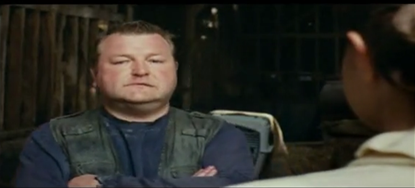- Alvarado's theory // Alvarado identified the four key themes in racial representations, these are:
- Exotic
- Dangerous
- Humorous
- Blocking - The positioning and movements of a character in relation to the camera.
- Canted angle // When the camera is placed on a slant, often used to portray the psychological uneasiness or tension in the subject being filmed.
- Diegetic sound // Sound which has a source on-screen, like dialogue.
- Establishing shot // A shot used at the start of a new scene that shows the audience where the action is taking place.
- Fast-paced editing // When scenes are edited together using lots of shots cut together quickly to create tension and to position the audience to see that the action is taking place quickly.
- Gender // A key area that can be studied in TV dramas that involves the binary differences between male and female characters.
- Hollywood montage // Where a series of short shots are edited into a sequence to condense space, time, and information.
- Invisible editing - A technique of editing shots together in a way that prevents the audience from noticing it.
- Jump cut // Two shots of the same subject are taken from camera positions that vary slightly.
- K
- Leon Festinger // Had the theory of 'Cognitive Dissonance' that argues that we resist adjusting our attitudes unless faced with overwhelming evidence against it. He believed that we seek out confirmation of our thoughts/benefits.
- Mise-en-scene // What is placed in the scene, including the setting, lighting, positioning of characters, casting, costume, make-up and props.
- Non-diegetic sound // Sound which does not have a source on-screen, like music.
- Old // An age group that contains characters in TV dramas that are commonly wise and cantankerous.
- Pan // Rotating or pivoting the camera horizontally.
- Q
- Roland Barthes // Created the 5 narrative codes, they are:
- Semantic code // Connotation (what you associate with it), Denotation (What it literally is)
- Action code // A narrated 'cue' that indicates further action
- Enigma code // A mystery to be solved
- Cultural code // A meaning only apparent to a particular group
- Symbolic code // Meaning created by 2 opposing images
- Shot-reverse-shot // When one character is shown looking at another character (often off-screen), and then the other character is shown looking "back" at the first character.
- Tessa Perkins // Identified how 5 stereotype assumptions can be challenged, these are:
- Stereotypes are not always negative
- They are not always about minority groups or the less powerful
- They can be held by one's own group
- They are not rigid or unchanging
- Unity // Where characters, of which are often of different ethnicities, work together in a TV drama.
- Verisimilitude // The construction of a believable world
- Wealth // Usually an attribute of the upper-class characters in a TV drama.
- Xenophobia // The dislike of prejudice against people from other countries.
- Youth // An age group that contains characters in TV dramas that are commonly helpless.
- Zoom // A camera shot that smoothly transits from a long shot to a medium or closeup shot.









